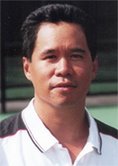The Modern
Two-Handed Backhand: Grips
By Doug Eng, EdD PhD
In the pro game, as in all levels of tennis, it's remarkable how many players now use the two-handed backhand. About 75% of the top men are two-handers. Among the women that percentage is 90% or higher.
The dominance of the two-hander is undoubtedly one explanation for the apparent monotony of playing styles. Virtually every player is some version of a baseliner, with some simply more aggressive than others.
Finding a pure serve-and-volley player on tour is as likely as finding a pearl while walking on the beach. Pure counterpunchers are almost as rare.
The dominance of the two-handed backhand has helped create the perception that top players are becoming carbon copies of each other. But is that really true?
The fact is that all two-handers are not the same. There are important differences in grips, backswings, elbow positions, and use of the wrist, all of which have implications for how the pros play. These implications are equally as important for players at all levels who want to improve their own two-handers.
In this article series, I will take a look at the diverse two-handed backhands on the tour today and what I think it means for tournament and club players. I'll classify the commonalities and discuss the major variations, starting with this month with an article on the grips.
This article will detail the different possible grips for both the top and the bottom hand, and how the players combine the possibilities. So far as I know this is the first truly comprehensive treatment of this overlooked and misunderstood subject. But it has major implications for your technique and level of play.
In future articles, I'll look at the backswings, the hitting arm shapes and the use of the wrist. This will put us in the position to evaluate what combinations of all these elements individuals players may want to develop, and how coaches can improve teaching the two-hander at all levels.
Associated Techniques
At the start of this series I want outline a fundamental concept I use for understanding all strokes in tennis, including the two-hander. This is what I call "associated techniques."
In my serve articles for Tennisplayer (Click Here) I introduced this concept for the first time. In looking at the serve, we saw how certain techniques or components are coupled and tend to go together in high quality technical motions.
As we saw in the serving series, many serving problems even at the tour level can be traced to players combining techniques that do not function effectively together.
For example, my study of elite servers showed that, to be effective, an abbreviated service motion needs to be coupled with a narrow stance, a lower toss, and a faster serving rhythm. A more classical motion, on the other hand, is associated with a higher toss and a slower rhythm.
Mixing abbreviated and classical elements indiscriminately can be disastrous. This explains the surprising difficulties that arose when players such as Novak Djokovic or Maria Sharapova tried to abbreviate their backswings.
In the past two years, both players tried to abbreviate their windups, going straight up with their arms like Andy Roddick, but retaining their previous stances, toss heights, and serving rhythms. As a result Djokovic's serve became basically dysfunctional in 2010, forcing him to abandon the experiment.
With hard work over time-- including studying video of his previous motion on Tennisplayer--he was able to recreate something very close to his original motion, going back to a more classic windup. The result was that he was gradually able to recover and even improve his serving effectiveness. Without recreating his old wind up in association with his slower rhythm and higher toss, it is unlikely he could have ever become the number one player.
Sharapova wasn't as lucky. She also failed in her experiment with the abbreviated wind up. Then, like Djokovic, she tried to go back to her previous more classical windup. But, unlike Novak, her recovery has produced inconsistency at critical times, a testament to the difficulty of fully eliminating the negative effects of coupling the wrong elements.
Two Handed Models
This concept of associated techniques is just as important in understanding the two-handed backhand. Just as on the serve, if players combine technical elements in the wrong way, the results can be less than optimum, or worse.
There are direct relationships between grips, backswings, and arm shapes that determine the ultimate effectiveness of the stroke, as well as effecting other shots such as the slice backhand, the drop shot and the volley.
So what are the various associated techniques used by top players and what do we need to understand about them in building or improving the two-hander? To answer that question, I studied over two dozen world class two-handed backhands on both the men's and women's tour.
Grips
In this article I will talk about the surprising results of that study, starting with the grips. We look at the range of grips on the bottom hand, then the top hand, then see how top players combine these grip options.
Conventional wisdom holds that the two-handed backhand can be hit using three different grips with the dominant or bottom hand. (The right hand for a right handed player.) The first is a forehand grip in which the bottom hand is unchanged or shifts to an eastern forehand. The second is a continental grip. The third is an eastern backhand grip.
But video analysis shows this belief about the three variations are untrue and don't apply for top players. Players rarely if ever use a true forehand grip with the bottom hand. It is equally rare to see them shift the bottom hand to the top of the frame and hit with an eastern backhand.
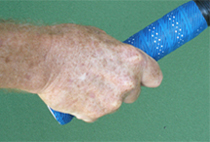 |
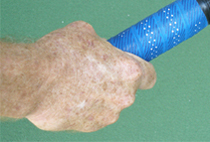 |
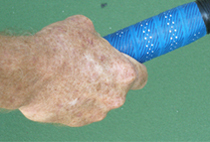 |
| Continental | Continental Backhand | Continental Forehand |
Actual bottom hand grips: Continental Continental Backhand Continental Forehand |
||
Instead, almost all players use some version of the continental. Most players have the index knuckle on the edge betweeb the second and third bevels. I call this continental. But many also use two modified versions. One variation shifts the knuckle up to bevel two. I call this the Continental backhand.
The other version shifts the knuckle downward somewhere between the continental and the eastern forehand. I call this the continental forehand. Some would call this an Australian grip. So pro players do in fact use three three grip variations with the bottom hand, just not the ones commonly supposed.
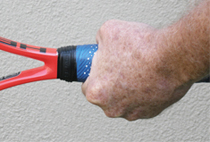 |
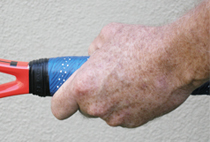 |
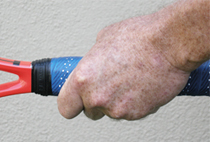 |
| Semi Western | Eastern | Eastern/Continental Hybrid |
Top Hand Grips: Semi Western Eastern Continental |
||
Top Hand
These three bottom hand positions can be combined with three additional grip variations with the top hand (the left hand for a right handed player.)
Some players such as Rafael Nadal or Martina Hingis hold the equivalent of a semi-western grip with the top hand. Counting down and around from the top of the frame, this means the index knuckle is on bevel 6.
But most players have the index knuckle closer to the top of the frame. One variation is with the knuckle and heelpadaligned behind the string bed in the equivalent of a left-handed eastern grip on bevel 6.
The third variation shifts the top hand slightly further to the top. Usually the index knuckle remains on the bevel right behind the handle, although for some players there can be a slight shift upward. the main difference is that the heel pad shifts further upward toward the top of the frame, resting partially on bevel 7. We can call this an Eastern Continental hybrid.
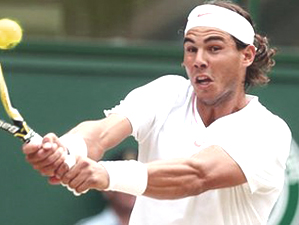 |
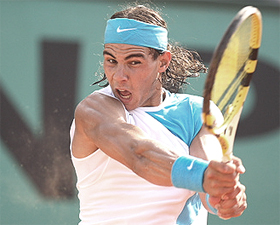 |
Two views of Nadal's grips: Continental Backhand with dominant hand, semi-western with top. |
|
But there is still one more twist. Some players who use this hybird grip shift the heel pad upward toward the continental, but actually at the same time slide the index knuckle down, closer to the semi-western position. Still part of the hand has moved toward the top of the frame, so the net result is probably quite similar to the version with the knuckle slightly higher up.
Combinations
So if there are basically three options with each hand, the question becomes how are these options actually combined? The answer is that you can find examples of players with virtually any possible combination.
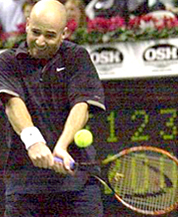 |
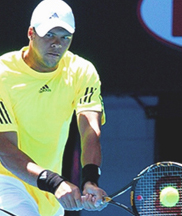 |
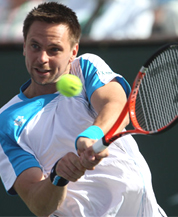 |
Agassi, Tsonga, Soderling: Note the Eastern/Contiental hybrid grips with the top lands. |
||
Let's take a look at some examples from top players and see how this works. Rafael Nadal, for starters, combines a continental backhand with his bottom dominant hand with a semi-western with the top. His index knuckle with the bottom hand is on bevel 2. His index knuckle with the top hand is on bevel 5. So, interestingly, his grips are both at the extreme. Bottom hand as far on top as anyone, and the top hand as far underneath.
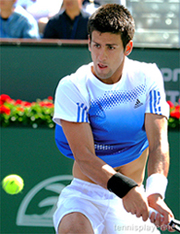 |
Djokovic: a continental backhand with the bottom hand and an eastern forehand with the top. |
Andre Agassi also uses a continental backhand with the bottom hand, but his top hand is at the other end of the extreme from Nadal, shifted to the eastern/continental hybrid, with the knuckle behind the handle and the heel pad more toward the top of the frame partially rotated upward on to bevel 7. Jo Willie Tsonga also uses this combination, as does Robin Soderling.
Novak Djokovic has a slightly less extreme grip with his bottom hand, what I call continental, compared to either Nadal or Agassi. Novak combines this with an eastern grip with the top hand with both the heel pad and the index knuckle in line with the string bed.
Novak uses this combination, however, to play up on the line taking the ball early in a fashion not dissimilar to Agassi who is more on top with both hands. Novak's combination is also used by David Nalbandian, another great two hander known for taking the ball early.
Nikolay Davydenko bottom hand is shifted down into what I call the continental forehand, but combines this weaker grip with a semi-western with the top hand. Yet despite the differences he plays up like Agassi or Djokovic.
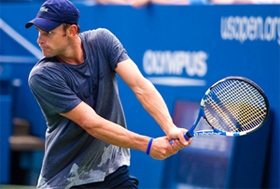 |
A weaker continental forehand with the bottom hand, and a continental on top. |
Andy Murray also has this weaker continental forehand bottom hand grip, but shifts the heel pad of his top hand toward the top of the frame and the index knuckle shifted downward similar to Nadal. Here is yet another combination, one Murray uses to defend well from deep in the court and as well as attack from the baseline.
Andy Roddick modeled his backhand on Agassi and has his top hand rotated toward the top of the frame in a eastern/continental hybrid with the top hand. But his bottom dominant hand is not the same strong position as Agassi's continental.
Instead it is in a much weaker position, a continental forehand that is actually similar to the bottom hand grip used by Williams sisters. We will see more about the problems of this particular grip combination in association with his backswing and elbow shapes in future articles.
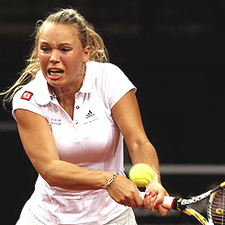 |
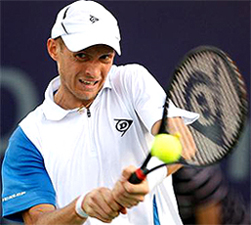 |
Wozniacki and Davydenko: continental forehand bottom with semi-western top. |
|
On the women's side, Caroline Wozniacki is actually similar to Davydenko, combining the weaker continental forehand with the bottom hand with a semi-western with the top. This is the same combination used by Serena and Venus Williams, who combine the continental forehand with a semi-western with the top hand, although Venus's bottom hand shift may be even slightly less shifted toward the top than her sister or Caroline.
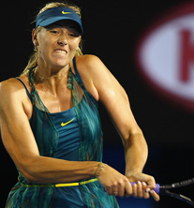 |
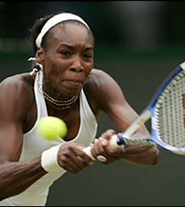 |
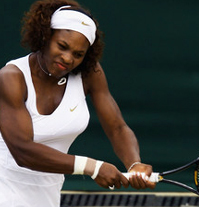 |
Sharapova: a little more on top with bottom hand. Venus and Serena: a little further down. |
||
Maria Sharapova on the other hand, is stronger with her bottom hand than Serena and Venus, shifting it a little higher to the continental backhand. She pairs this with an eastern grip behind the handle with the top hand, so her combination is actually similar to Djokovic.
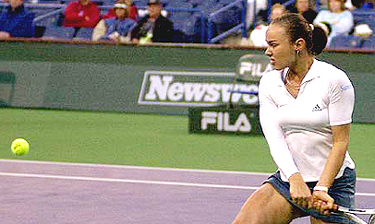 |
|
Martina Hingis: a true continental paired with a semi-western. |
|
Martina Hingis is one of the few women to hit with a strong continental backhand grip with the bottom hand, but she pairs this with a semi-western grip with the bottom hand, a combination that like Wozniacki is also similar to Rafael Nadal.
Technical and Tactical Associations
What does it all mean? Even with this brief run down we can see that the backhand grips for the two-hander are quite varied, and paired in the full range of possible combinations. And the fact is that both men and women have succeeded with these different combinations and used them in a wide range of playing styles.
The question is however, what, if any, are the associations between these grips and the other technical and tactical elements? How do players enhance or limit themselves with grips when they are paired with other aspects of their technique or game style?
From the discussion above we can see there are certain possible correlations between grip combinations and playing style. For example it makes sense that a player like Nadal or Wozniacki would be more underneath with a semi-western grip with the top hand, since both tend to play deep in the court and deal with many higher balls.
And it makes since that players who take the ball early on a consistent basis like Agassi or Tsonga would have both hands positioned closer to the top of the racket.
But the relationship isn't black and white. Djokovic is dominating the game by playing close to the line and he has a slightly weaker grip with his bottom hand than Nadal or Agassi, and an eastern forehand with the top hand. Davydenko is another player who consistently takes the ball very early, yet his grip with his top hand is semi-western like Nadal.
The conclusion is probably that different options may work for certain players who discover this through experimentation, rather than following rigid textbook dictates. Yet all the combinations fall within a certain range. For example, no players are using true eastern forehands with the bottom hand or extreme semi-westerns with the top.
Grips and Slice
However, there is probably a clearer association when we look at the grips--and specifically the grip with the bottom hand--and the ability to hit with underspin on the one-handed slice backhand, the drop shot, and the volleys.
The fact is that the best volleys and slices are usually played by all-court players with a one-handed backhand. This makes perfect sense, since proper mechanics of the slice and backhand volley obviously require the correct use of the dominant arm.
For two-handed backhands, this ability to use the dominant arm is most readily achieved by players with stronger grips with the bottom hand. Many of the two-handed players with the best slices and all court components play with either a continental grip with the bottom hand or a continental backhands, giving the dominant arm a greater role in the two-handed stroke.
Martina Hingis is one of the few women two-handers to hit with a continental backhand grip with the bottom hand, and plays a tremendously complete all court game. She possesses technically cleaner volleys than any other female player studied for this article. It's possible that using the bottom, dominant hand and arm more in thousands and thousands of two handed baseline strokes may help the body transition to the shots that are purely one-handed.
On the men's side, Rafael Nadal with a bottom hand continenta backhandl grip similar to Hingis has incorporated more and more one-handed backhand slice and net attack. No doubt this all court dimension has factored into his success and commentators such as John McEnroe have consistently praised his technical volleys.
Jo Wilfred Tsonga is another player with a strong all court component in his game style, and again, a two-hander who plays with a continental backhand grip with the bottom hand. Djokovic, with the slightly weaker continental grip, also slices very effectively and has interjected net play successfully into his game.
Interestingly, the Williams sisters, despite their ability to dominate the court with groundstrokes, attack the net relatively rarely and also play minimal numbers of slice backhands. As noted, both are using very mild continental forehand grips.
I have noticed this same issue involving grip and underspin with many junior and college players I have worked with in recent years who used the same weaker continental forehand on the two-hander. These players tended to use the same grip on the slice, the drop shot and the volleys.
Most hit backhand volleys that were typically heavily spun and did not penetrate the court. So they tended to sit up a bit like drop shots, reducing effectiveness.
The main reason for this is that with the continental forehand, the face of the racket tends to be too open creating more spin but less pace. In addition, most players using the continental forehand also have bent elbows, something we will look at more closely in a future article.
The bent front elbow can cause a problem in transiting to the volley since the elbow on the volley tends to straighten out at contact. When these players moved a slight grip turn toward the continental and improved the arm position, the backhand volley instantly penetrated more and had greater pace and depth. But not every player wanted to make these adjustments.
Many teaching pros, however, still teach the two-hander allowing students to use an eastern forehand grip with the dominant hand. For recreational players who play a few times a year, that grip may be sufficient. And if a player's strength is the baseline and he or she also has a very good drop shot, I'm not sure if changing the grip should be a main focus.
But the fact is you rarely see a strong player use a true forehand grip with the dominant hand, and this is non-existent at the pro level. For players competing year-round and investing money in lessons, camps, and tournaments, the wrong grip can be very limiting. My belief is any player who seeks to become a more complete player should make the change to at a continental or continental backhand. But as this article shows that, beyond this most basic point, there are a range of successful ways to combine the two hands on the racket.
What to reccomend? A good place to start is with the continental/eastern combination and then allow the pro to adjust, or suggest adjustments based on how the stroke develops. The bottom hand could stay put or shift further to the top. The top hand could shift slightly in either direction and still be within sound technical parameters.
Still there are other important questions to ask: how do the different grips work in association with the differing backswing shapes and hitting arm positions? Is it possible that a certain grip may be perfectly effective when combined with certain backswings or elbow shapes, but a liability when associated with others? Stay Tuned!



